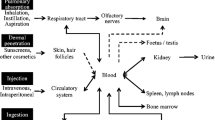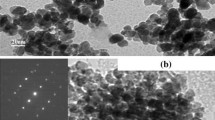Abstract
A number of dermal toxicological studies using TiO2 nanoparticles exist which are based on the study of various animal models like mice, rabbits etc. However, a well-defined study is lacking on the dermal toxic effects of TiO2 nanoparticles on rats, which are the appropriate model for systemic absorption study of nanoparticles. Furthermore, toxicity of TiO2 nanoparticles varies widely depending upon the size, concentration, crystallinity, synthesis method etc. This study was conducted to synthesize TiO2 nanoparticles of different sizes (∼15 to ∼30 nm) by aqueous method, thereby evaluating the concentration-dependent toxicological effects of the ∼20-nm sized nanoparticles on Wistar rats. Characterization of the particles was done by transmission electron microscope, dynamic light scattering instrument, X-ray diffractrometer, and ultraviolet spectrophotometer. The toxicity study was conducted for 14 days (acute), and it is observed that TiO2 nanoparticles (∼20 nm) at a concentration of 42 mg/kg, when applied topically showed toxicity on rat skin at the biochemical level. However, the histopathological studies did not show any observable effects at tissue level. Our data suggest that well-crystallized spherical-shaped ∼20 nm anatase TiO2 nanoparticles synthesized in aqueous medium can induce concentration-dependent biochemical alteration in rat skin during short-term exposure.









Similar content being viewed by others
References
Bernard BK, Osheroff MR, Hofmann A et al (1990) Toxicology and carcinogenesis studies of dietary titanium dioxide-coated mica in male and female fischer 344 rats. J Toxicol Environ Health 29(4):417–429
Hurum DC, Agrios AG, Gray KA (2003) Explaining the enhanced photocatalyt activity of degussa P25 mixed-phase TiO2 using EPR. J Phys Chem 107:4545–4549
Hurum DC, Gray KA (2005) Recombination pathways in the degussa P2 formulation of TiO2: surface versus lattice mechanisms. J Phys Chem 109:977–980
Cho M, Chung H, Choi W et al (2004) Linear correlation between inactivation of e coli and OH radical concentration in TiO2 photocatalytic disinfection. Water Res 38(4):1069–1077
Ackroyd R, Kelty C, Brown N et al (2001) The history of photodetection and photodynamic therapy. Photochem Photobiol 74:656–669
Davis JM, Wang A, Shatkin JA et al. (2009) External review draft nanomaterial case studies: nanoscale titanium dioxide in water treatment and in topical sunscreen. US Environmental Protection Agency, Research Triangle Park. pp 5–31
Borm PJ, Robbins D, Haubold S et al (2006) The potential risks of nanomaterials: a review carried out for ECETOC. Particle Fibre Toxicol 3:11
Ne A, Xia T, Madler L et al (2006) Toxic potential of materials at the nanolevel. Science 311:622–627
Wang JX, Zhou GQ, Chen CY et al (2007) Acute toxicity and biodistribution of different sized titanium dioxide particles in mice after oral administration. Toxicol Lett 168:176–185
Brown JS, Zeman KL, Bennett WD (2002) Ultrafine particle deposition and clearance in the healthy and obstructed lung. Am J Respir Crit Care Med 166:1240–1247
Kreyling WG, Semmler M, Erbe F et al (2002) Translocation of ultrafine insoluble iridium particles from lung epithelium to extrapulmonary organs is size dependent but very low. J Toxicol Environ Health 65:1513–1530
Oberdoerster G, Sharp Z, Atudorei V et al (2004) Translocation of inhaled ultrafine particles to the brain. Inhal Toxicol 16:437–445
Oberdorster G, Oberdorster E, Oberdorster J (2005) Nanotoxicology:an emerging discipline evolving from studies of ultrafine particles. Environ Health Perspect 113:823–839
Muller J, Huaux F, Moreau N et al (2005) Respiratory toxicity of multi-wall carbon nanotubes. Toxicol Appl Pharmacol 207:221–231
Chen HW, Su SF, Chien CT et al (2006) Titanium dioxide nanoparticles induce emphysema-like lung injury in mice. FASEB J 20:1732–1741
Liu HT, Ma LL, Zhao JF et al (2009) Biochemical toxicity of nano-anatase TiO2 particles in mice. Biol Trace Elem Res 129(1):170–180
Ma LL, Zhao JF, Wang J et al (2009) The acute liver injury in mice caused by nano-anatase TiO2. Nanoscale Res Lett 4:1275–2128
Duan YM, Liu J, Ma LL et al (2010) Toxicological characteristics of nanoparticulate anatase titanium dioxide in mice. Biomaterials 31:894–899
Cui Y, Liu H, Zhou M et al (2010) Signaling pathway of inflammatory responses in the mouse liver caused by TiO2 nanoparticles. J Biomed Mater Res A 96(1):221–229. doi:10.1002/jbm.a.32976
Afaq F, Abidi P, Matin R et al (1998) Cytotoxicity, pro-oxidant effects and antioxidant depletion in rat lung alveolar macrophages exposed to ultrafine titanium dioxide. J Appl Toxicol 18:307–312
Warheit DB, Webb TR, Reeda KL et al (2007) Pulmonary toxicity study in rats with three forms of ultrafine-TiO2 particles: differential responses related to surface properties. Toxicology 230:90–104
Warheit DB, Hoke RA, Finlay C et al (2007) Development of a base of toxicity tests using ultrafine TiO2 particles as a component of nanoparticle risk management. Toxicol Lett 171:99–110
Liu R, Yin LH, Pu YP et al (2009) Pulmonary toxicity induced by three forms of titanium dioxide nanoparticles via intra-tracheal instillation in rats. Prog Nat Sci 19(5):573–579
Wang J, Li N, Zheng L et al (2011) P38-Nrf-2 signaling pathway of oxidative stress in mice caused by nanoparticulate TiO2. Biol Trace Elem Res, doi: 10.1007/s12011-010-8663-8.
Gamer AO, Leibold E, Van Ravenzwaay B (2006) The in vitro absorption of microfine zinc oxide and titanium dioxide through porcine skin. Toxicol In Vitro 20:301–307
Kiss B, Biro T, Czifra G et al (2008) Investigation ofmicronized titanium dioxide penetration in human skin xeno-grafts and its effect on cellular functions of human skin-derived cells. Exp Dermatol. doi:10.1111/j.1600-0625.2007.00683
NANODERM (2007) Quality of skin as a barrier to ultra-fine particles. Final Report. (Project Number: QLK4-CT-2002-02678). Available at: http://www.uni-leipzig.de/*nanoderm/
Menzel F, Reinert T, Vogt J, Butz T (2004) Investigations of percutaneous uptake of ultrafine TiO2 particles at the high energy ion nanoprobe LIPSION. Nucl Instrum Methods Phys Res B 219–220:82–86
Kertesz ZS, Szikszai Z, Gontier E et al (2005) Nuclear microprobe study of TiO2-penetration in the epidermis of human skin xenografts. Nucl Instrum Methods Phys Res B 231:280–285
Bennat C, Muller-Goymann CC (2000) Skin penetration and stabilization of formulations containing microfine titanium dioxide as physical UV filter. Int J Cosmet Sci 22:271–283
Habig WH, Pabst MJ, Jokoby WB (1974) Glutathione-S-transferase—the first enzymatic step in mercapturic acid formation. J Biol Chem 249:7130–7139
Claiborne A (1985) Catalase activity. In: Greenwald RA (ed) Handbook of methods for oxygen free radical research. CRC Press, Boca Raton, pp 283–284
Misra HP, Fridovich I (1972) The role of superoxide anion in the auto-oxidation of epinephrine and a simple assay for superoxide dismutase. J Biol Chem 247:3170–3175
Wright JR, Colby HD, Miles PR (1981) Cytosolic factors which affect microsomal lipid peroxidation in lung and liver. Arch Biochem Biophys 206:296–304
Lowry OH, Rosebrough NJ, Farr AL et al (1951) Protein measurement with the folin phenol reagent. J Biol Chem 193:265–275
Newman MD, Stotland M, Ellis J (2009) The safety of nanosized particles in titanium dioxide- and zinc oxide-based sunscreens. J Am Acad Dermatol 61:685–692
Shayne CG (2006) Animal models in toxicology, 2nd edn. Taylor & Francis, New York, p 177
Warheit DB, Hoke RA, Finlay C et al (2006) CM Pulmonary instillation studies with nanoscale TiO2 rods and dots in rats: toxicity is not dependent upon particle size and surface area. Toxicol Sci 91:227–236
Domingos RF, Tufenkji N, Wilkinson KJ et al (2009) Aggregation of titanium dioxide nanoparticles: role of a fulvic acid. Environ Sci Technol 43:1282–1286
French RA, Jacobson AR, Kim B et al (2009) Influence of ionic strength, pH, and cation valence on aggregation kinetics of titanium dioxide nanoparticles. Environ Sci Technol 43:1354–1359
Jemec A, Drobne D, Remskar M et al (2008) T Effects of ingested nanosized titanium dioxide on terrestrial isopods porcellio scaber. Environ Toxicol Chem 27:1904–1914
Acknowledgments
Authors are thankful to University Grants Commission, Government of India, New Delhi, for providing meritorious research fellowship and funding to carry out the experiment. The authors are also thankful to Prof. GN Qazi Vice-Chancellor, Hamdard University for providing infrastructure for this research.
Conflicts of Interest Statement
None.
Author information
Authors and Affiliations
Corresponding author
Rights and permissions
About this article
Cite this article
Unnithan, J., Rehman, M.U., Ahmad, F.J. et al. Aqueous Synthesis and Concentration-Dependent Dermal Toxicity of TiO2 Nanoparticles in Wistar Rats. Biol Trace Elem Res 143, 1682–1694 (2011). https://doi.org/10.1007/s12011-011-9010-4
Received:
Accepted:
Published:
Issue Date:
DOI: https://doi.org/10.1007/s12011-011-9010-4




